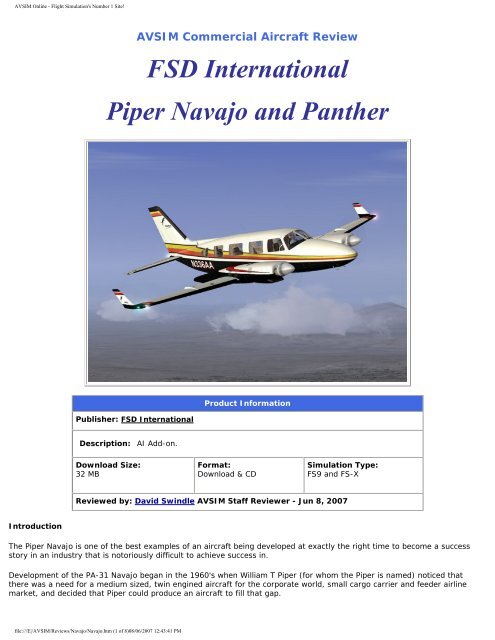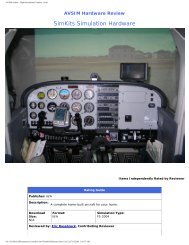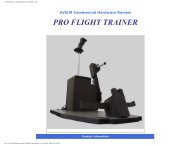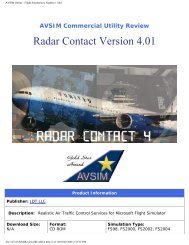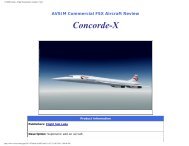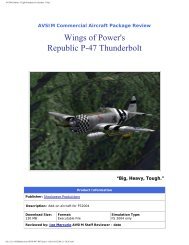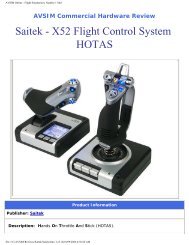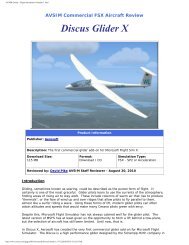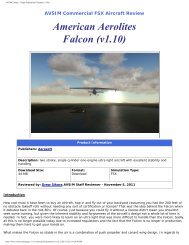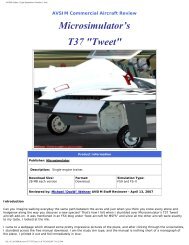FSD Piper Navajo - Avsim
FSD Piper Navajo - Avsim
FSD Piper Navajo - Avsim
Create successful ePaper yourself
Turn your PDF publications into a flip-book with our unique Google optimized e-Paper software.
AVSIM Online - Flight Simulation's Number 1 Site!<br />
Introduction<br />
AVSIM Commercial Aircraft Review<br />
<strong>FSD</strong> International<br />
<strong>Piper</strong> <strong>Navajo</strong> and Panther<br />
Publisher: <strong>FSD</strong> International<br />
Description: AI Add-on.<br />
Download Size:<br />
32 MB<br />
Product Information<br />
Format:<br />
Download & CD<br />
Simulation Type:<br />
FS9 and FS-X<br />
Reviewed by: David Swindle AVSIM Staff Reviewer - Jun 8, 2007<br />
The <strong>Piper</strong> <strong>Navajo</strong> is one of the best examples of an aircraft being developed at exactly the right time to become a success<br />
story in an industry that is notoriously difficult to achieve success in.<br />
Development of the PA-31 <strong>Navajo</strong> began in the 1960's when William T <strong>Piper</strong> (for whom the <strong>Piper</strong> is named) noticed that<br />
there was a need for a medium sized, twin engined aircraft for the corporate world, small cargo carrier and feeder airline<br />
market, and decided that <strong>Piper</strong> could produce an aircraft to fill that gap.<br />
file:///E|/AVSIM/Reviews/<strong>Navajo</strong>/<strong>Navajo</strong>.htm (1 of 8)08/06/2007 12:43:41 PM
AVSIM Online - Flight Simulation's Number 1 Site!<br />
After it was launched, the <strong>Navajo</strong> was almost an instant success. Over 2000 <strong>Navajo</strong>s of various versions were produced<br />
before the production line shut down in 1984 amidst a lawsuit-driven downturn in the general aviation market. Throughout<br />
the production run of the <strong>Navajo</strong>, several versions were introduced that added more powerful engines, pressurization of a<br />
bigger cabin, and other refinements. In addition to the <strong>Navajo</strong>, <strong>Piper</strong> also produced the Chieftain, which was basically a<br />
bigger, more powerful <strong>Navajo</strong> intended for commuter airline use.<br />
Even though the <strong>Navajo</strong> line stopped production over twenty years ago, the aircraft are still very popular with charter<br />
companies as well as small cargo companies that fly feeder routes for bigger cargo carriers.<br />
Because the <strong>Navajo</strong> fleet is aging and beginning to suffer from fatigue and general wear and tear, a company by the name of<br />
Colemill Enterprises in Nashville, Tennessee has found considerable success in modifying <strong>Navajo</strong>s and Chieftains into what<br />
are known as Panthers.<br />
The Panther conversion runs about $164,000 (in addition to the cost of the aircraft to be modified) and adds new 350HP<br />
engines with dual drive magnetos, four bladed “Q-tip” propellers, as well as a Shadin fuel management computer and new<br />
oil and fuel hoses for the engines. Colemill also offers “Zip-Tip” winglets (as a $7500 option) which increases stability and<br />
also shortens the takeoff and landing distance required by the Panther. They also add landing lights that can be used inflight<br />
to make the aircraft more visible.<br />
Compared to a stock <strong>Navajo</strong>, the Panther gets off the ground in less distance, climbs and cruises faster, is quieter and more<br />
stable in flight, and has a shorter landing roll. Aside from the performance benefits bestowed by the Panther conversion, the<br />
modifications also dramatically increase the single-engine climb rate, which makes the Panther far safer in the event of an<br />
engine failure.<br />
Installation & Documentation<br />
The <strong>FSD</strong> <strong>Navajo</strong>\Panther package is available as either a 32MB download for $29.95 (USD) or on a CD for $34.95.<br />
Test System<br />
Asus M2N-SLI Deluxe<br />
Motherboard<br />
AMD Athlon 64 X2 5000+<br />
Nvidia Geforce 7900GT<br />
2GB RAM<br />
300GB HDD<br />
Saitek X52 Pro<br />
CH ProPedals<br />
Windows XP<br />
Flying Time:<br />
40 hours<br />
After purchasing the product, <strong>FSD</strong> will send an e-mail with license information which needs<br />
to be put into the installer before it will work. The installer itself is pretty straightforward, but<br />
because it does have to connect to the internet to verify the purchase, some problems can<br />
arise with firewalls and anti-virus software, both of which should be disabled before running<br />
the installer.<br />
Once the installer has run, it is necessary to run the load managers (the <strong>Navajo</strong> and Panther<br />
both have their own) to get the aircraft configured and working correctly in FSX. The load<br />
manager allows the user to adjust realism and “maintenance” settings for the aircraft, as<br />
well as add new paint schemes and to change weight and balance. Although the load<br />
manager sounds complicated, it is quite simple to understand and very easy to use.<br />
After running the load manager, it is a good idea to read the manuals that <strong>FSD</strong> have<br />
included. They provide information on how to use the load manager as well as a very<br />
detailed overview of the systems in the aircraft, checklists and performance data.<br />
Unlike some other payware aircraft, the checklists and reference pages on the FSX<br />
kneeboard actually do contain checklists and reference data (although cruise performance<br />
data is only available in the manual), which makes the <strong>Navajo</strong> and Panther very easy to fly in FSX without having to do a<br />
bunch of printing from the PDF manual just to start the engines.<br />
2D Panel<br />
Although FSX has advanced virtual cockpits to the point where 2D panels are almost unneeded, <strong>FSD</strong> has included a very<br />
impressive panel with the <strong>Navajo</strong>\Panther package that is actually very useful within FSX.<br />
The panel itself (the <strong>Navajo</strong> and Panther share the same basic panel in FSX) is very detailed, and shows a realistic amount of<br />
weathering, which is very appropriate for aircraft that are over two decades old. Like most other <strong>FSD</strong> panels, clicking on the<br />
primary flight instruments brings up larger versions of them. The gauges are large and sharp enough in the normal panel<br />
view that the pop-up gauges probably won't be used much, except on very small monitors. In addition to the pop-up<br />
gauges, there are also several other pop-up panels for things like the throttle quadrant, fuel selectors, overhead switches,<br />
GPS (although this is visible on the 2D panel normally), as well as some engine instruments that (in the real aircraft) are<br />
located on the far right side of the panel, past what the FSX panel shows.<br />
file:///E|/AVSIM/Reviews/<strong>Navajo</strong>/<strong>Navajo</strong>.htm (2 of 8)08/06/2007 12:43:41 PM
AVSIM Online - Flight Simulation's Number 1 Site!<br />
2D panel 2D Panel Pop-ups<br />
As might be expected, all of the instruments and controls function properly, and <strong>FSD</strong> have also added nice touches like a<br />
removable yoke and working sun visor. The panel also includes impressive night-lighting that looks extremely realistic and<br />
gives a very convincing impression of depth.<br />
During my testing, I noticed no drop in performance in the 2D panel, and given that FSX still suffers from the poor VC<br />
lighting that plagued FS9, it is nice to have a 2D panel that can be used for instrument approaches.<br />
Virtual Cockpit<br />
One of the biggest advantages that FSX holds over FS9, is the improvement in virtual cockpit instruments. Despite being a<br />
slightly older design, the <strong>Navajo</strong>/Panther have VC's that hold up very well even when compared to aircraft designed<br />
specifically for FSX.<br />
As in the 2D panel, the <strong>Navajo</strong> and Panther models both use essentially the same VC layout, which is correct since the<br />
Panther conversion doesn't require any noticeable changes to the cockpit.<br />
The modeling in the VC itself is top notch, with the entire interior of the aircraft being rendered in 3D. <strong>FSD</strong> has included<br />
several “easter egg” animations for things like armrests, the sun visors, and even the refrigerator in the back of the cabin.<br />
<strong>FSD</strong> have also added working windshield wipers (which also move in the external view) and removable yokes, but the fact<br />
that FSX doesn't have rain effects in the VC means that the wipers don't actually do anything.<br />
The VC VC Overhead<br />
Much like the 2D panel, the instruments are all very sharp and easy to read. Clicking on the primary flight instruments in the<br />
VC brings up the same enlarged version of the instruments that appear in the 2D panel, which is a nice touch. In addition to<br />
looking nice, the instruments all move very fluidly with no noticeable hesitation or lagging. The VC also features some<br />
impressive night-lighting effects, which do a very good job of simulating the post lights found in the real aircraft.<br />
<strong>FSD</strong> has done an impressive job on the VC textures, which make the passenger seats look quite comfortable while showing<br />
wear and tear on the controls in the cockpit. Although most of the textures look very nice, there are a few areas in the<br />
cockpit that use lower resolution textures which results in some areas (like the landing gear lever and surrounding area)<br />
standing out from the rest of the texturing.<br />
For the most part, all of the switches and controls in the VC can be clicked and used, but in some situations the VC can be a<br />
file:///E|/AVSIM/Reviews/<strong>Navajo</strong>/<strong>Navajo</strong>.htm (3 of 8)08/06/2007 12:43:41 PM
AVSIM Online - Flight Simulation's Number 1 Site!<br />
bit of a problem. The overhead panel, which contains the electrical, lighting and climate control switches as well as the<br />
starters and magneto switches, work almost flawlessly as do the controls and instruments on the main panel. But the fuel<br />
selector and autopilot (which are located on the floor) sometimes fail to respond to mouse clicks for reasons I couldn't figure<br />
out.<br />
The fuel selectors are also a bit puzzling, since they seem to function slightly differently from their 2D counterparts which<br />
can lead to situations where the VC and 2D fuel selectors show the engines running on completely different tanks.<br />
<strong>Navajo</strong> VC Panther VC<br />
Despite the level of detail and complexity of the VC, it doesn't have much of an impact on performance. I actually saw<br />
slightly higher frame rates than in some of the default aircraft.<br />
External Model and Textures<br />
Although the <strong>Navajo</strong>\Panther package originally dates back to FS9 and the models weren't purpose built for FSX, the<br />
external models and textures still look very impressive. The models themselves are almost flawless, with almost every<br />
possible detai, from the windshield wiper to the curtains on the passenger windows being modeled. <strong>FSD</strong> have done a very<br />
good job of capturing the differences between the <strong>Navajo</strong> and Panther; with the Panther sporting it's distinctive cowlings,<br />
propellers and winglets, complete with landing lights.<br />
The <strong>Navajo</strong>\Panther both have all of the standard animated controls surfaces, landing gear, and propeller blades that are<br />
expected of a modern payware aircraft are there, as well as a couple of extra touches like the animated windshield wiper, a<br />
window shade, pitot covers and chocks that appear when the aircraft is on the ground with the parking brake set.<br />
Blue & Gold <strong>Navajo</strong> AmeriFlight <strong>Navajo</strong> <strong>Navajo</strong><br />
After flying both the <strong>Navajo</strong> and Panther for some time, the only flaw I could find in the model is the fact that the Q-tip<br />
propellers on the Panther lack the distinctive bend back tips present on the real aircraft, which I assume was probably due to<br />
some limitation with how FSX handles animations for propellers.<br />
“Out of the box”, the Panther and <strong>Navajo</strong> only come with one texture each, but there are quite a few available for free from<br />
the <strong>FSD</strong> website that use auto-installers and the load manager to make installation very simple.<br />
file:///E|/AVSIM/Reviews/<strong>Navajo</strong>/<strong>Navajo</strong>.htm (4 of 8)08/06/2007 12:43:41 PM
AVSIM Online - Flight Simulation's Number 1 Site!<br />
Denim Panther Fishy Panther Tazmanian Panther<br />
The textures cover a wide variety of paint schemes, from well worn cargo carriers to elaborate private schemes, and all are<br />
of a uniformly high quality. Most of the textures show a reasonable amount of weathering for private or corporate aircraft,<br />
with some other paint schemes being liberally covered in dirt and exhaust staining. All of the textures make use of shine<br />
effects, which is used just enough to be convincing without making the textures excessively dull or shiny.<br />
Although the textures are of very high quality, I did notice one problem with them. For some reason, the texture mapping<br />
seems to be slightly misaligned for the left and right sides of the fuselage on both the Panther and <strong>Navajo</strong>. This<br />
misalignment is most visible on textures that have a band of color running around the aircraft, since the bands don't quite<br />
line up where the textures meet at the nose.<br />
Another thing I noticed with the textures (which isn't a flaw in the product) is the fact that even though the repaint installers<br />
have the option of installing the texture for both the <strong>Navajo</strong> and Panther, many of the repaints have a Panther emblem on<br />
the tail which looks decidedly odd on the <strong>Navajo</strong>. After some fiddling around, I discovered that it is possible to use freeware<br />
image editors to remove the Panther badging, although it takes some time to do so.<br />
Despite there being quite a high level of detail on both the external models and textures, they don't seem to have much of<br />
an effect on performance. I noticed no performance difference from the <strong>FSD</strong> aircraft to the default FSX models which is good<br />
news for people without cutting edge systems.<br />
Flight Model<br />
If there is one area that <strong>FSD</strong> is best known for, it's their ability to create amazingly realistic flight dynamics, especially in the<br />
area of twin engine aircraft which are very poorly modeled in FS by default. The <strong>Navajo</strong> and Panther really show off <strong>FSD</strong>'s<br />
expertise in flight modeling.<br />
On both the <strong>Navajo</strong> and Panther, take off is pretty straightforward due to counter-rotating propellers, and even though both<br />
aircraft rotate at about the same speed, the Panther is noticeably quicker to get to rotation speed thanks to the four bladed<br />
propellers.<br />
After takeoff, climb power is set at 38 inches of manifold pressure and 2500RPM, and the differences between the Panther<br />
and stock <strong>Navajo</strong> begin to make themselves more apparent. At the recommended climb power setting and speed, the <strong>Navajo</strong><br />
will climb at between 1000 and 1500FPM, whereas the <strong>Navajo</strong> will head upstairs at over 2000FPM.<br />
Once at cruise altitude (which can be anywhere up to 24,000 ft, although the real-world aircraft rarely exceed), the <strong>Navajo</strong><br />
will cruise at about 200kts with the Panther being about 15kts faster at the same power setting and fuel flow. Although both<br />
aircraft matched the published figures for power settings versus airspeed almost exactly, the fuel flows for both aircraft<br />
seem to be about 20% too low. From my research, I found that at 75% power at a best power mixture, the <strong>Navajo</strong> and<br />
Panther (since the FS versions are both modeled with the same engines) should burn about 20GPH per engine. The FSX<br />
versions only burn about 15-16GPH at the same power settings regardless whether auto mixture is used. After some<br />
experimentation, I discovered that changing the fuel flow scalar in the aircraft.cfg for both the <strong>Navajo</strong> and Panther to 1.166<br />
resulted in fuel flows that were within 1GPH per engine for most power settings. This resulted in ranges that were<br />
considerably closer to the published specifications.<br />
file:///E|/AVSIM/Reviews/<strong>Navajo</strong>/<strong>Navajo</strong>.htm (5 of 8)08/06/2007 12:43:41 PM
AVSIM Online - Flight Simulation's Number 1 Site!<br />
Panther Taxiing Rolling on take off Shutdown<br />
Although the <strong>Navajo</strong> is designed to go from point A to point B quickly, the flight dynamics really shine in maneuvering flight<br />
and in engine out situations. The <strong>Navajo</strong> and Panther are both very stable, and if put into a bank, require only small rudder<br />
and aileron inputs to stay at the desired bank angle without requiring huge aileron inputs to keep from rolling back out of the<br />
turn. Once trimmed correctly, both aircraft are very stable which makes hand-flying them very pleasant. This combination of<br />
stability and ease of maneuverability makes it very easy to hand-fly the <strong>Navajo</strong> and Panther in almost any weather<br />
condition, and it makes instrument approaches (especially ILS approaches) much easier.<br />
In addition to having excellent hand-flying characteristics, <strong>FSD</strong> have also done a very impressive job with the engine out<br />
handling of the <strong>Navajo</strong> and Panther.<br />
One area where twin engine aircraft for MSFS have traditionally run into problems, is in simulating Vmca. On twin engine<br />
aircraft, Vmca is the lowest speed the aircraft can safely be operated on one engine. Below that speed, insufficient airflow<br />
exists over the control surfaces to prevent the aircraft from rolling or yawing uncontrollably towards the dead engine. On<br />
most MSFS aircraft (including the default aircraft in FSX), slowing below Vmca with the remaining engine at full power<br />
results in no particular handling difficulties, which is incredibly inaccurate.<br />
On the <strong>Navajo</strong> and Panther, <strong>FSD</strong> have done a very good job of simulating this loss of control. If the airspeed is allowed to<br />
bleed off too far, both the <strong>Navajo</strong> and Panther will become impossible to control until the airspeed increases enough for the<br />
flight controls to become effective again. I was also pleased to see that <strong>FSD</strong> have correctly modeled the effects of propeller<br />
feathering, and the <strong>Navajo</strong> and Panther both show a very noticeable degradation in both single engine climb and cruise<br />
unless the inoperative engine is feathered.<br />
Panther at cruise Engine out<br />
Another area where <strong>FSD</strong> have done an excellent job, is in representing the fact that the Panther has significantly better<br />
single-engine performance than the stock <strong>Navajo</strong>. With one engine out, the <strong>Navajo</strong> will climb at about 400FPM, but the<br />
Panther can climb at about 750FPM under the same conditions.<br />
Aside from the engine-out handling characteristics, the <strong>FSD</strong> <strong>Piper</strong>s are also very pleasant to fly on approaches. The fact that<br />
both aircraft are very stable means that descents only require a power reduction, which results in a very nice, stable descent<br />
that can be controlled very precisely by simply adjusting the throttles. On final approach, once the gear and flaps are down<br />
and the power set, both <strong>Piper</strong>s settle easily into either a VFR approach in perfect weather or an ILS in poorer conditions.<br />
Landing is a simple matter of keeping the power set for 100kts over the fence and then just reducing power while<br />
maintaining a constant pitch attitude to a smooth landing.<br />
file:///E|/AVSIM/Reviews/<strong>Navajo</strong>/<strong>Navajo</strong>.htm (6 of 8)08/06/2007 12:43:41 PM
AVSIM Online - Flight Simulation's Number 1 Site!<br />
Service & Support<br />
Inside the cabin<br />
Sounds<br />
The real <strong>Navajo</strong> is known for being a loud aircraft for those who fly it, and this<br />
comes across well in the <strong>FSD</strong> package. The interior sounds do an excellent job of<br />
conveying what it would sound like to actually fly a <strong>Navajo</strong>, with a lot of propeller<br />
noise (thanks to the fact that the props are almost in line with the front seats of the<br />
aircraft) and a nice engine note mixed in. As throttle and propeller settings are<br />
changed, the sounds change accordingly and there are also the usual gear and flap<br />
sounds. The exterior sounds are also very well done, and do an excellent job of<br />
representing what a pair of turbocharged six cylinder engines sound like.<br />
The only thing I didn't like about the sounds was the fact that both the <strong>Navajo</strong> and<br />
Panther share a sound set. While both aircraft use the same engines, the Q-tip<br />
propellers fitted to the Panther are significantly quieter than those fitted to the<br />
<strong>Navajo</strong>, which doesn't come through in the <strong>FSD</strong> versions.<br />
Although the Panther and <strong>Navajo</strong> are fairly basic as FS add-on aircraft go, <strong>FSD</strong> offers excellent support if something does go<br />
wrong.<br />
<strong>FSD</strong> offers support through both e-mail and a support forum. Both options seem to work equally well, with responses being<br />
delivered in under 24 hours and often within an hour or two.<br />
In addition to a helpful support system, <strong>FSD</strong> have also done an admirable job of patching their product; with several service<br />
releases having been produced to fix a variety of small issues that showed up in the first release of the product.<br />
Conclusion<br />
Now comes the critical question; Is the <strong>FSD</strong> Panther/<strong>Navajo</strong> package worth the money?<br />
My opinion is that the package is indeed worth the money, with two aircraft being represented, each with their own set of<br />
superb flight dynamics. Although the <strong>Navajo</strong> and Porter don't contain all of the bells and whistles that are starting to appear<br />
in newer, purpose designed FSX aircraft, they still look extremely good, and the excellent flight dynamics, sounds, and VC<br />
more than compensate for any lack of eye candy present in the models.<br />
Overall, even with a few small hiccups (which are all pretty minor), the <strong>FSD</strong> <strong>Navajo</strong> and Panther are superb aircraft that are<br />
an excellent alternative to the default Baron and provide an extremely realistic flying experience.<br />
What I Like About The <strong>Navajo</strong> & Panther<br />
● Comprehensive documentation.<br />
file:///E|/AVSIM/Reviews/<strong>Navajo</strong>/<strong>Navajo</strong>.htm (7 of 8)08/06/2007 12:43:41 PM<br />
● Load manager makes installing extra textures and setting up the<br />
aircraft simple.<br />
● Excellent flight dynamics, especially with single-engine handling.<br />
● Well done VC, 2D panel, and external model, with almost no FPS<br />
impact.<br />
● Many repaints available with auto installers.<br />
● Excellent support.<br />
What I Don't Like About The <strong>Navajo</strong> & Panther
AVSIM Online - Flight Simulation's Number 1 Site!<br />
file:///E|/AVSIM/Reviews/<strong>Navajo</strong>/<strong>Navajo</strong>.htm (8 of 8)08/06/2007 12:43:41 PM<br />
● Some controls in VC can work sporadically.<br />
● Texture mismatch on fuselage.<br />
● Cruise fuel flow set too low.<br />
Printing<br />
If you wish to print this review or read it offline at your leisure, right click<br />
on the link below, and select "save as"<br />
<strong>FSD</strong> <strong>Piper</strong> <strong>Navajo</strong><br />
(adobe acrobat required)<br />
Comments?<br />
Standard Disclaimer<br />
The review above is a subjective assessment of the product by the author. There is no<br />
connection between the producer and the reviewer, and we feel this review is unbiased<br />
and truly reflects the performance of the product in the simming environment. This<br />
disclaimer is posted here in order to provide you with background information on the<br />
reviewer and any connections that may exist between him/her and the contributing<br />
party.<br />
Tell A Friend About this Review!<br />
© 2007 - AVSIM Online<br />
All Rights Reserved


